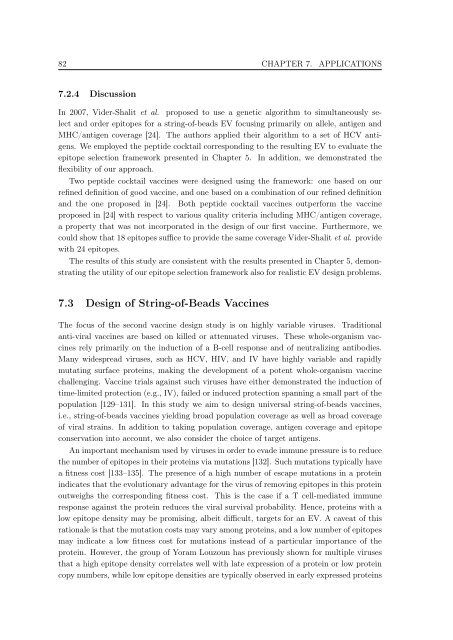New Approaches to in silico Design of Epitope-Based Vaccines
New Approaches to in silico Design of Epitope-Based Vaccines
New Approaches to in silico Design of Epitope-Based Vaccines
Create successful ePaper yourself
Turn your PDF publications into a flip-book with our unique Google optimized e-Paper software.
82 CHAPTER 7. APPLICATIONS<br />
7.2.4 Discussion<br />
In 2007, Vider-Shalit et al. proposed <strong>to</strong> use a genetic algorithm <strong>to</strong> simultaneously select<br />
and order epi<strong>to</strong>pes for a str<strong>in</strong>g-<strong>of</strong>-beads EV focus<strong>in</strong>g primarily on allele, antigen and<br />
MHC/antigen coverage [24]. The authors applied their algorithm <strong>to</strong> a set <strong>of</strong> HCV antigens.<br />
We employed the peptide cocktail correspond<strong>in</strong>g <strong>to</strong> the result<strong>in</strong>g EV <strong>to</strong> evaluate the<br />
epi<strong>to</strong>pe selection framework presented <strong>in</strong> Chapter 5. In addition, we demonstrated the<br />
flexibility <strong>of</strong> our approach.<br />
Two peptide cocktail vacc<strong>in</strong>es were designed us<strong>in</strong>g the framework: one based on our<br />
ref<strong>in</strong>ed def<strong>in</strong>ition <strong>of</strong> good vacc<strong>in</strong>e, and one based on a comb<strong>in</strong>ation <strong>of</strong> our ref<strong>in</strong>ed def<strong>in</strong>ition<br />
and the one proposed <strong>in</strong> [24]. Both peptide cocktail vacc<strong>in</strong>es outperform the vacc<strong>in</strong>e<br />
proposed <strong>in</strong> [24] with respect <strong>to</strong> various quality criteria <strong>in</strong>clud<strong>in</strong>g MHC/antigen coverage,<br />
a property that was not <strong>in</strong>corporated <strong>in</strong> the design <strong>of</strong> our first vacc<strong>in</strong>e. Furthermore, we<br />
could show that 18 epi<strong>to</strong>pes suffice <strong>to</strong> provide the same coverage Vider-Shalit et al. provide<br />
with 24 epi<strong>to</strong>pes.<br />
The results <strong>of</strong> this study are consistent with the results presented <strong>in</strong> Chapter 5, demonstrat<strong>in</strong>g<br />
the utility <strong>of</strong> our epi<strong>to</strong>pe selection framework also for realistic EV design problems.<br />
7.3 <strong>Design</strong> <strong>of</strong> Str<strong>in</strong>g-<strong>of</strong>-Beads Vacc<strong>in</strong>es<br />
The focus <strong>of</strong> the second vacc<strong>in</strong>e design study is on highly variable viruses. Traditional<br />
anti-viral vacc<strong>in</strong>es are based on killed or attenuated viruses. These whole-organism vacc<strong>in</strong>es<br />
rely primarily on the <strong>in</strong>duction <strong>of</strong> a B-cell response and <strong>of</strong> neutraliz<strong>in</strong>g antibodies.<br />
Many widespread viruses, such as HCV, HIV, and IV have highly variable and rapidly<br />
mutat<strong>in</strong>g surface prote<strong>in</strong>s, mak<strong>in</strong>g the development <strong>of</strong> a potent whole-organism vacc<strong>in</strong>e<br />
challeng<strong>in</strong>g. Vacc<strong>in</strong>e trials aga<strong>in</strong>st such viruses have either demonstrated the <strong>in</strong>duction <strong>of</strong><br />
time-limited protection (e.g., IV), failed or <strong>in</strong>duced protection spann<strong>in</strong>g a small part <strong>of</strong> the<br />
population [129–131]. In this study we aim <strong>to</strong> design universal str<strong>in</strong>g-<strong>of</strong>-beads vacc<strong>in</strong>es,<br />
i.e., str<strong>in</strong>g-<strong>of</strong>-beads vacc<strong>in</strong>es yield<strong>in</strong>g broad population coverage as well as broad coverage<br />
<strong>of</strong> viral stra<strong>in</strong>s. In addition <strong>to</strong> tak<strong>in</strong>g population coverage, antigen coverage and epi<strong>to</strong>pe<br />
conservation <strong>in</strong><strong>to</strong> account, we also consider the choice <strong>of</strong> target antigens.<br />
An important mechanism used by viruses <strong>in</strong> order <strong>to</strong> evade immune pressure is <strong>to</strong> reduce<br />
the number <strong>of</strong> epi<strong>to</strong>pes <strong>in</strong> their prote<strong>in</strong>s via mutations [132]. Such mutations typically have<br />
a fitness cost [133–135]. The presence <strong>of</strong> a high number <strong>of</strong> escape mutations <strong>in</strong> a prote<strong>in</strong><br />
<strong>in</strong>dicates that the evolutionary advantage for the virus <strong>of</strong> remov<strong>in</strong>g epi<strong>to</strong>pes <strong>in</strong> this prote<strong>in</strong><br />
outweighs the correspond<strong>in</strong>g fitness cost. This is the case if a T cell-mediated immune<br />
response aga<strong>in</strong>st the prote<strong>in</strong> reduces the viral survival probability. Hence, prote<strong>in</strong>s with a<br />
low epi<strong>to</strong>pe density may be promis<strong>in</strong>g, albeit difficult, targets for an EV. A caveat <strong>of</strong> this<br />
rationale is that the mutation costs may vary among prote<strong>in</strong>s, and a low number <strong>of</strong> epi<strong>to</strong>pes<br />
may <strong>in</strong>dicate a low fitness cost for mutations <strong>in</strong>stead <strong>of</strong> a particular importance <strong>of</strong> the<br />
prote<strong>in</strong>. However, the group <strong>of</strong> Yoram Louzoun has previously shown for multiple viruses<br />
that a high epi<strong>to</strong>pe density correlates well with late expression <strong>of</strong> a prote<strong>in</strong> or low prote<strong>in</strong><br />
copy numbers, while low epi<strong>to</strong>pe densities are typically observed <strong>in</strong> early expressed prote<strong>in</strong>s

















